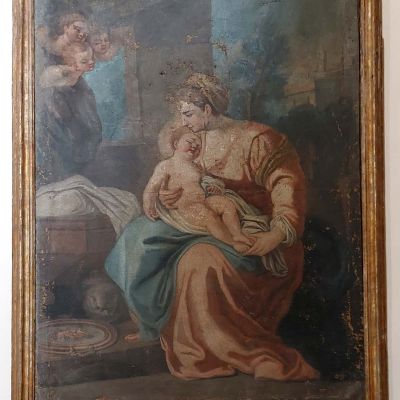Church of Saint Mary of Loreto
The church of the Madonna di Loreto was built in 1615 on the site were a previous chapel of the same name once stood and from which the image of the Vergine Lauretana was recovered. The Franciscan historian Serafino Profilo, in his manuscript of 1760, provides us with precise information about the historical events that led to the construction of the church and the attached monastery.
According to Profilo, the church was built by Giulia Farnese, the wife of the prince Gian Antonio Albricci, feudal lord of Mesagne, to follow up on a vow made to the Madonna of Loreto. The noblewoman had asked the Madonna to free her husband who had been detained in Naples by the viceroy Pietro Fernandez de Castro for reasons unknown to us.
She committed to building a new, bigger church if her husband returned home. After his release, Giulia Farnese ordered, in 1615, the construction of the church and the attached monastery, in which the Minori Osservanti (Order of Friars Minor) first took up residence, followed by the Riformati (Continental Reformed Protestants). Work continued up to 1630. In the following years, various work was carried out such as the covering of the rood in 1672 and the altar of the San Pasquale, decorated in stucco commissioned by the De Angelis family.
In 1727, vaulted chapels were added in the eastern part of the church. In addition to the Albricci and De Angelis families, other nobles contributed to the construction of the church and monastery including the noblewoman Costanza Selvaggi in 1631, Maria Vasquez de Ummana in 1638, Caterina Graziana in 1644 and the nobleman Giuseppe Resta in 1730. In 1790, the historian Antonio Mavaro states that the church was decorated with stuccoes. It is likely that the decorations were carried out by the Neapolitan Pasquale Faiella, who for many years worked in Mesagne also creating, amongst other things, the stuccoes in the Chiesa Madre (Mother Church).
In 1852, at the behest of the Mesagnese Antonio Mauro, the church was given a vaulted roof. The monastery belonged to the Franciscans until the suppression of the order in 1809. It returned to them from 1822 until 1866. In 1868, the monastery was ceded to the Municipality because it was assigned to be the local hospital. Naturally, it underwent major structural changes although it is still possible to see the cloister incorporated in the old hospital today.
Internally, some 17th and 18th century paintings are still preserved including S. Antonio di Padova con Bambino (Saint Anthony of Padova with Child), la Vergine Immacolata (Mary of the Immaculate Conception) by Friar Giacomo of San Vito, la Madonna di Loreto, San Gaetano da Thiene (Saint Cajetan of Thien), S. Sebastiano Martire (Blessed Saint Sebastian Martyr), l’Estasi di S. Francesco (Ecstasy of Saint Francis), L’Estasi di San Francesco d’Assisi (Ecstasy of Saint Francis of Assisi), Madonna del Carmine and San Pasquale Baylon. And finally, Transito di S. Giuseppe Partriarca, S. Lucia Martire and San Rocco from the 18th century. The wooden choir, probably from the 18th century, is also worth highlighting.










